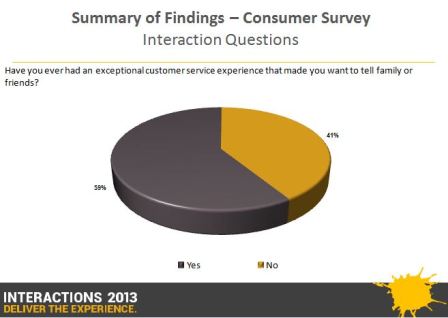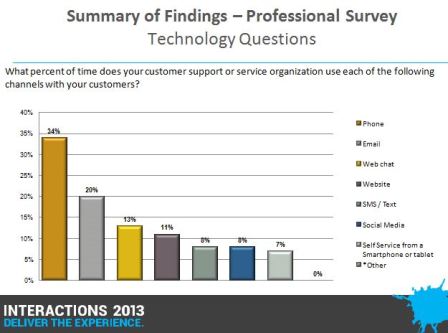As a prelude to the closing session of the Interactive Intelligence Interactions 13 event, the company’s CMO Joe Staples informed me that some “interesting and surprising” research was going to be revealed. Was he ever correct!
While the full surveys results will not be available for review until next week, Interactions 13 attendees got more than a sneak peak of the results of interviews done between February 28, 2013, and March 25, 2013, with 1407 consumers and 453 contact center professionals across a sample that spanned customer segments and geographies around the world. The surveys were designed to find out perspectives on two basic questions:
Below are two of the higher level findings that live up to the Staples’ characterization of the survey. They are interesting, surprising and terrific food for thought regarding where we are and what the contact center community needs to be looking at.
Consumers first
On the consumer side of things, what should be on people’s radar screens was the following:

Source: Interactive Intelligence
It should be noted that in answer to a later question, 73 percent of consumers said they had shared a customer experience, both good and bad, on a social network.
The question that arises is whether 59 percent is a good number or just a starting point for sharing good experiences. One hopes it is actually the latter. The intense concentration of companies large and small around the world is on improving customer experiences to the point where not only do they create loyalty, but they turn pleased customers into brand advocates. In fact, what is surprising, and an interesting reflection of the impact social media has had on business, it that consumers actually do share their delight with friends and family.
One would have thought this number would be lower in that most people tend to be quick to complain and are judicious with praise. What it did validate were the observations made by the event’s feature industry expert panel, who admonished the audience, saying that people are talking and that at a minimum you need to know who they are and what they are saying.
A sample of the other questions detailed in the survey results include:
There are several other questions equally as intriguing, including what customers like and dislike about interactions when using their mobile devices. However, one that really resonated was the question: “Would you be willing to pay a fee to receive a higher level of services.” Seventy-seven percent of consumers said no, since they felt good customer service is an integral part of doing business, 14 percent said they would pay if reasonable and 9 percent said yes they would pay, but only for capabilities from select providers. You should also look at the results that show even in a mobile world, people still want the intimacy and immediacy of interacting with another person in real-time via a phone call to get their concerns addressed.
The message to the industry was loud and clear. Customers expect/demand to be treated with respect and not have to earn it with their dollars. It is why great customer service is emerging as a core competitive differentiator. There are also important warnings in the results, including one contained in the answer to a question as to whether a company had responded to their concerns when contacted; only 54 percent said yes. Another one that is implied is that over-reach by vendors who want to be paid for customer service could be making decisions that could be hazardous to their financial health. And, last but not least, voice is and will remain a vital means of interaction.
Is the industry ready?
If customers have great expectations, the questions surrounding where the providers are were equally interesting. I won’t disclose too much because of limited space, but the short answer is the industry has a way to go.

Source: Interactive Intelligence
Without going into the details behind this, there seems to be a mismatch between time spent where customers want results, i.e., the phone, and time spent responding to e-mail. In a real-time world where you don’t get a second chance to make a first impression and where competitors are a click away along with a megaphone (social media) for complaining, the gap exposed here needs to be closed.
As with the consumer survey results, there is a lot more granularity that you will be able to digest next week regarding contact center readiness to leverage technology to improve the customer experience, and we will be providing the link as soon as it becomes available.
In closing it is worth showing what Interactive Intelligence feels are the 10 key findings and conclusions from this exercise:
As noted at the top, the findings were illuminating. As a snapshot, the state of customer interactions may not be “priceless” as a famous credit card commercial likes to tout but certainly quite valuable.